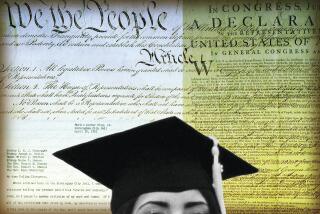Bennett Proposes Curriculum for an Ideal High School
WASHINGTON — Secretary of Education William J. Bennett today presented his vision of an ideal high school in which every American teen-ager would take 36 required courses, from algebra and art history to science and Western civilization.
Bennett invoked a personal hero to name both his report and his ideal scholastic regimen: “James Madison High School: A Curriculum for American Students.”
Although there are legions of U.S. schools named after the fourth President of the United States, Bennett’s Madison High School is fictional. However, he stressed that it has real-world models, and he appended to the report capsule descriptions of seven high schools that practice what he preaches.
One of them is James A. Garfield High School in Los Angeles, known for its Latino students’ scores on calculus advanced placement exams.
In Bennett’s visionary school, only a quarter to a third of courses would be electives.
Bennett would have all teen-agers take four years of English, with four yearlong literature courses; three years each of science, mathematics and social studies; two years of foreign language; two years of physical education, during which students would be taught “the facts of life . . . in an open, serious and moral context, emphasizing restraint and the importance of the family,” and one semester each of art and music history.
Core Curriculum Advocate
The education secretary has been a longtime champion of a core curriculum with more academic backbone.
“Even by the standards of most other industrialized nations, American education is more comprehensive, more prolonged and more democratic,” Bennett wrote. “But, too often, it is also less rigorous and less productive.”
High schools typically have six or seven periods a day, allowing students to take 48 to 56 courses over four years.
Bennett said his scheme would leave “at least 25% of available class time” for electives and other study, from band to driver’s education to shop classes.
“That’s a lot,” said Bennett. “It should be enough.”
The law that created Bennett’s department bars him from mandating any curriculum for anybody.
But he said he is free to vent his opinions about what the 12 million American teen-agers in the nation’s 21,000 public and private high schools should be taught. It is “the kind of basic program most Americans want for their schools,” he said.
Scott D. Thomson, executive director of the National Assn. of Secondary School Principals, said, “I think it makes a lot of good sense. The better schools in the country already offer the kind of curriculum that he’s talking about.”
‘Junk Food Electives’
Too often students can fill their schedules with “junk food electives,” Thomson said. But he questioned the omission of business or vocational courses from Bennett’s core, saying, “It’s important to keep kids in school who are not going on to college.”
Gordon Cawelti, executive director of the Assn. for Supervision and Curriculum Development, said Bennett’s proposal reflects “the kind of education a lot of students now are receiving in upper middle-class suburbs, the Scarsdales and New Triers of America. . . . It remains to be tested whether all children can handle that kind of fare.”
Thomson said 25% to 30% of U.S. high schools now offer a curriculum like Bennett’s. Cawelti said that “at best” 10% of students pursue such a course.
More to Read
Sign up for Essential California
The most important California stories and recommendations in your inbox every morning.
You may occasionally receive promotional content from the Los Angeles Times.










